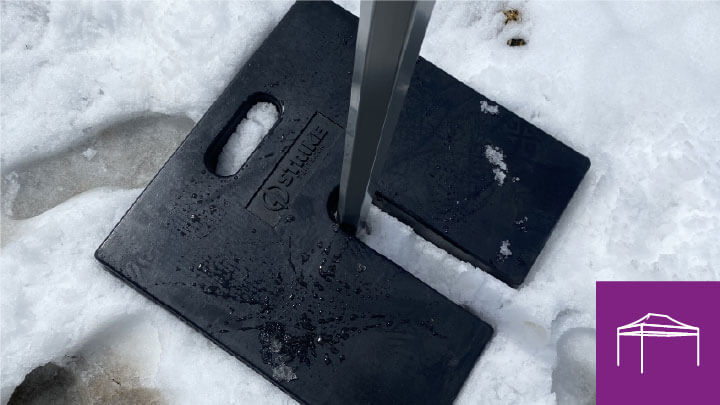Recently updated on June 18th, 2025
Have you ever experienced setting up a canopy tent only to have it blown away by the wind moments later? It’s a frustrating and costly situation that outdoor enthusiasts and event planners frequently encounter.
The best canopy for windy conditions should have a sturdy frame, durable fabric, and secure anchoring. Look for steel or reinforced aluminum frames and vented tops to reduce wind resistance. Use weighted bags, stakes, or ropes for extra stability.
Here, we’ll share a few tips on how to keep canopy from blowing away. But first, what is a canopy tent and why is it important to secure it?
Definition of Canopy: What is a Canopy Tent?
A canopy tent is a portable shelter that you can use for different outdoor events. It’s made up of a simple frame and a fabric top that keeps you shaded from the sun or dry when it rains. Whether you’re heading to the beach, setting up a booth at a local market, or throwing a backyard party, a canopy tent gives you quick and easy cover outdoors.
People also call them pop-up tents or event tents. They’re super easy to set up and pack away, which makes them great for all kinds of activities. You’ll see them at cookouts, festivals, craft fairs—even camping trips. They come in different sizes and colors, so there’s something for everyone. If you’re looking for something that offers shade, comfort, and convenience on the go, a canopy tent is a solid choice.
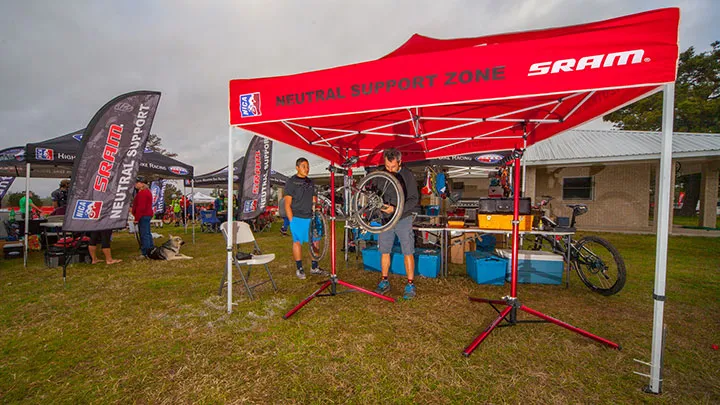
Importance of Securing Canopy Tents
Securing a canopy tent is important to keep it from being lifted by the wind. Strong gusts can cause safety risks and damage nearby objects. Use sandbags, stakes, or weights to anchor the tent. The best method depends on the surface—sandbags for beaches and stakes for grassy areas.
In addition to securing the canopy tent, it’s essential to monitor the weather conditions. Extreme weather conditions like strong winds, heavy rain, and thunderstorms can cause damage to the tent. And it’s best to take it down in these instances.
It’s also recommendable to avoid placing the canopy tent under trees or power lines that could fall onto the tent during a storm. Following these safety precautions and securing the canopy tent can ensure a safe and enjoyable outdoor event.
Failing to secure your canopy tent in high winds is a recipe for disaster. The strong wind gusts can easily rip the fabric or bend the poles, leaving you stranded and helpless in these unkind situations.
Factors Affecting Canopy Stability
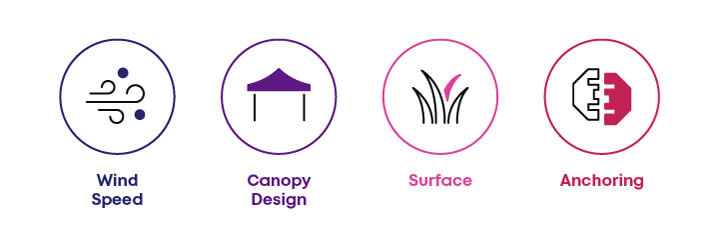
Before we dive into the best ways to secure your canopy tent, it’s crucial to understand the factors that affect its stability.
Wind Speed
Wind speed can affect the stability of your canopy. When the wind is strong, there is a greater risk of the canopy tent tipping over, especially if it’s not securely anchored or designed to withstand high winds.
Canopy Design
The design of your canopy tent can also affect its stability.
Different designs may have varying levels of wind resistance, with domed or aerodynamic designs generally being more stable than flat-roofed ones.
Surface
The surface where you set up your canopy can impact its stability. A level and flat surface are best for anchoring your canopy tents, while uneven or sloping surfaces can make it more challenging to secure your canopy and increase the risk of it toppling over.
Anchoring
Properly anchoring your canopy is crucial to making it stable. Try using stakes, sandbags, or other weighted objects to secure your canopy tent to the ground and prevent it from being blown away by strong winds.
The number and type of anchor points needed will depend on the size and shape of your canopy, the same as wind speed and other environmental factors.
Choosing the Right Canopy for Windy Conditions
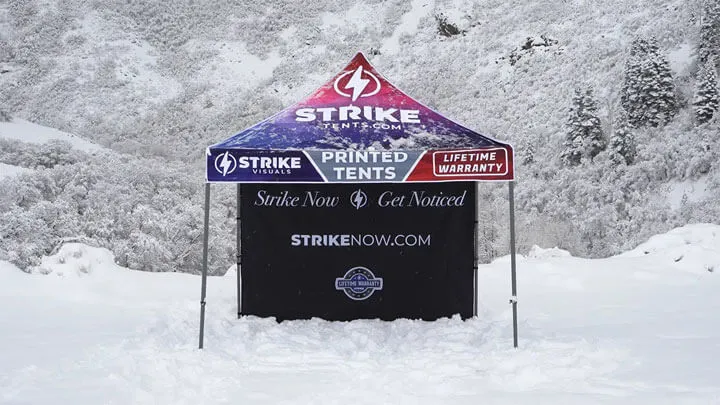
Picking the appropriate canopy for windy conditions can be a smart move that saves you from stress and inconvenience. A windproof canopy should have a sturdy frame and vented top to reduce wind resistance. The best way to hold down a canopy is by using weighted bags, stakes, or ropes.
When you choose a sturdy and wind-resistant canopy tent, you enjoy the outdoor activity or event. Knowing that it will stay put and protect you from the elements. Here are some things to consider when selecting a canopy tent:
Material
Choosing the appropriate material is crucial for a canopy tent that can withstand windy conditions. Most canopies are made from durable materials such as reinforced polyester or heavy-duty vinyl, which are tough and resistant to tearing or punctures. These materials also tend to be more water-resistant, which is crucial if you expect rain or storms.
Design
The design of the canopy tent is also critical when it comes to wind resistance. Look for a tent with an aerodynamic shape, which will help it cut through the wind a lot easier. Avoid tents with flat roofs or canopies with large openings on the sides, which can catch the wind and make the tent more susceptible to the wind blowing it away.
You can also look for tents with curved or sloped roofs, which can help to distribute wind forces more evenly across the tent.
Choose a canopy tent with an aerodynamic design that can withstand high wind speeds. Avoid tents with flat roofs or large openings or holes on the sides that block wind in.
Size
Smaller tents are generally more stable in windy conditions than larger ones. Smaller canopies are less likely to be blown over because they don’t catch as much wind due to their smaller size. If you expect strong winds, choose a smaller canopy tent.
If you need a big canopy tent, you can still choose a large one. But make sure to pick a sturdy one with a sturdy design that can resist high wind conditions.
5 Best Ways How To Keep Canopy From Blowing Away
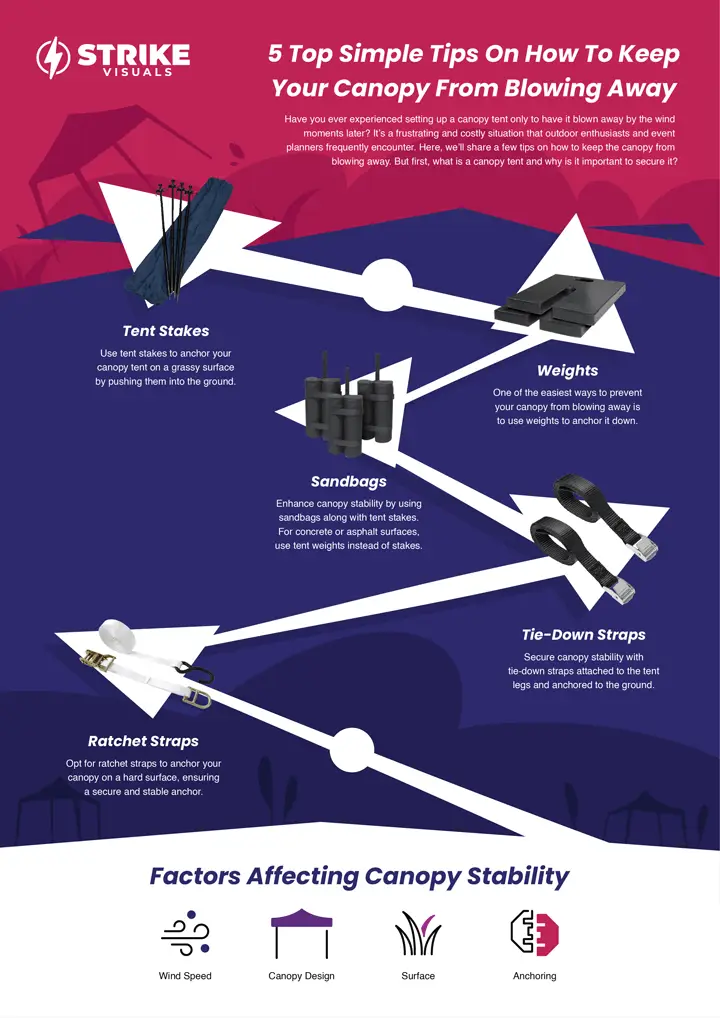
Now you’ve selected the right canopy tent to withstand the harsh winds, let us find the best ways to secure it.
Use Weights
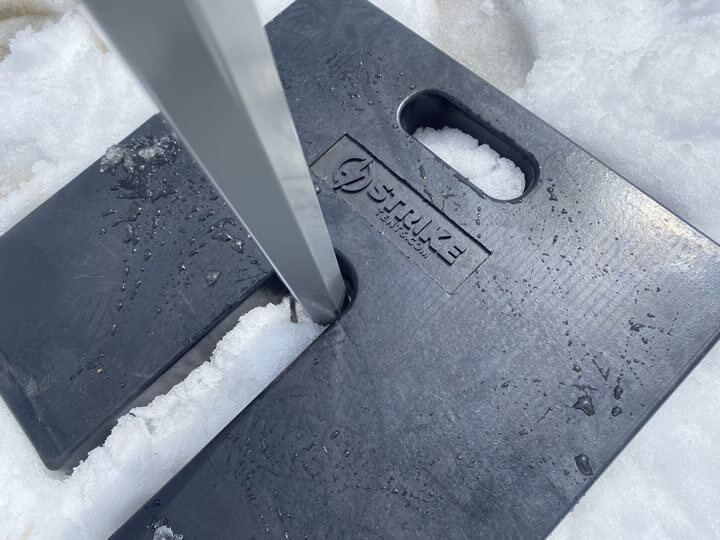
One of the easiest ways to prevent your canopy from blowing away is to use weights to anchor it down.
Use water weights, exercise weights, or large rocks to provide enough weight to keep the canopy tent intact.
Place the weight at each corner of the canopy tent or along the legs of the canopy frame to provide maximum stability. Fill sandbags or buckets with sand and place them on the legs of the canopy tent. You can also use water weights or plates.
Tie down the Canopy
Tie-down straps are an excellent way to keep your canopy tent in place. Attach the straps to the canopy tent’s legs and anchor them to the ground.
Another effective method is to tie down the canopy using ropes or bungee cords. This method is effective when you set up the canopy tent on grass or other soft surfaces. Attach the ropes or bungee cords to the canopy frame and stake them into the ground using tent stakes. Make sure to pull them tight to keep the canopy from moving.
Use Sandbags
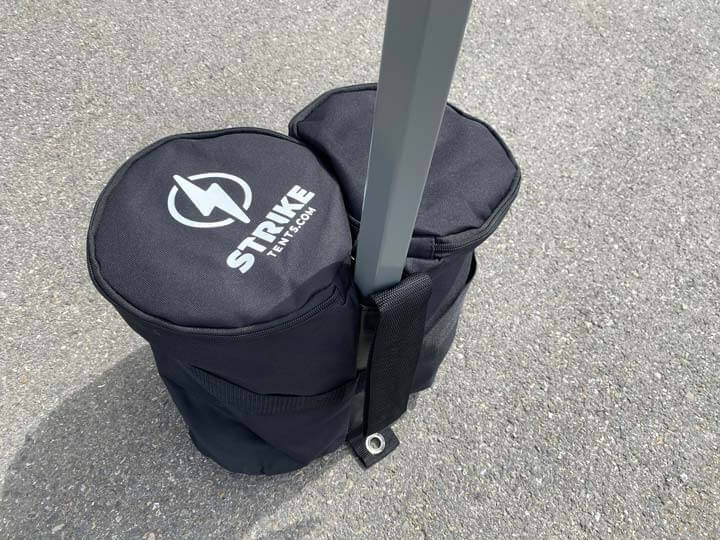
To enhance the stability of your canopy, you can consider using sandbags in addition to tent stakes. They are an easy and cost-effective way to anchor your canopy tent.
You can fill them with sand or pebbles and attach them to the canopy legs. Doing this will provide extra weight to withstand windy conditions. If you are setting up your pop-up canopy on concrete or asphalt where stakes could be unusable, tent weights are necessary.
In extreme situations with beach sand, where specialized canopy weights are unavailable, you can fill an old pillowcase with sand and firmly tie it to the canopy’s leg.
Use Tent Stakes
Tent stakes are perfect for anchoring your canopy tent on a grassy surface. Push the stakes into the ground, attach them to the tent’s legs, and secure them with a rope or tie-down strap. Use heavy-duty steel stakes as designed outdoors and drive them into the ground as deeply as possible for maximum stability.
You can also use them to anchor the canopy frame to the ground or attach them to ropes or bungee cords to create a more secure tie-down system.
Use Ratchet Straps
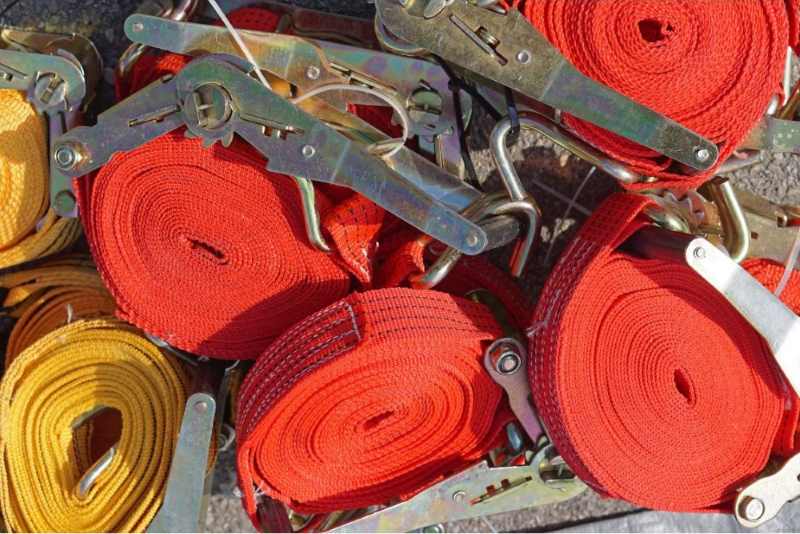
Ratchet straps are another option for anchoring your canopy to a hard surface. These straps help tighten them down securely, providing a sturdy and stable anchor point. Use them to attach the canopy tent to a sturdy anchor point like a tree or a fence post or to secure weights or sandbags to the canopy frame.
Conclusion
In summary, keeping your canopy from blowing away is crucial to ensure a safe and successful outdoor event. Wind speed, wind direction, canopy design, surface, and anchoring all play a role in canopy stability.
Choosing the appropriate canopy for windy conditions and using weights, tie-downs, sandbags, tent stakes, or ratchet straps are some of the best ways to keep your canopy secured and tent secure. Always follow manufacturer instructions for proper setup, anchoring, and setup to ensure the safety of your guests and property.
FAQs:
How much wind can a pop-up canopy take?
Most pop-up canopies can tolerate winds up to 30 MPH if set up and anchored correctly.
However, before using your pop-up canopy tent, check the weather forecast to ensure the winds will be below 30 MPH. If the winds are said to be stronger than that, it’s best to pick another day to set up your pop up tent or canopy again.
How much weight do you need to hold down a 10×10 canopy?
To anchor a 10×10 canopy tent properly on concrete or other hard surfaces, you’ll need at least 200 pounds of weight.
How do I keep my canopy tent from blowing away on concrete?
So you can quickly anchor your tent, use tent weights, cinder blocks, or exercise weights. A simple way to prevent your canopy from flying away on a windy day is to attach 5-gallon buckets filled with sand, gravel, water, or concrete to the tent using bungee cords. It’s an easy and affordable solution that can help to keep your canopy stable and secure in windy conditions.
Another option is to create tent weights by filling PVC pipes with concrete, capping them, and attaching them to the tent with bungee cords.
What is the best way to anchor a canopy?
The best way to anchor a canopy is with sandbags. Sand is an accessible and affordable option for anchoring your tent, as it is heavy enough to keep your setup secure when evenly distributed across the tent’s frame.
How to secure a canopy in the wind?
To secure a canopy in the wind, use heavy-duty stakes or sandbags at each leg. Attach guy lines to anchor points and secure them with strong pegs. Lower the canopy height to reduce wind resistance. In strong winds, take down the canopy to prevent damage.
